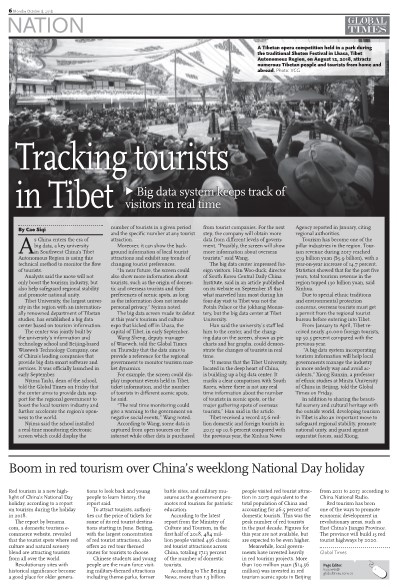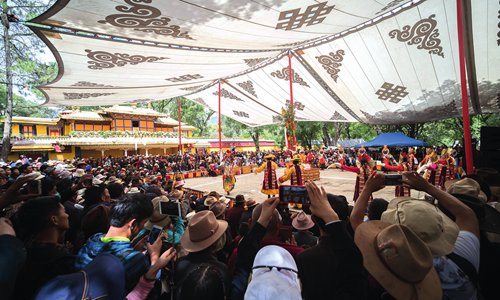
《环球时报》刊文:Tracking tourists in Tibet
韩国《中央日报》网站9月18日在头条位置刊发该报中国研究所所长韩友德的文章。韩友德在文章中称,近期他访问了西藏,行程中让他印象最深的并非布达拉宫、大昭寺等著名景点,而是西藏大学大数据中心,因为这意味着,位于中国腹地深处的西藏大学建起了被誉为第四次工业革命“宠儿”的大数据中心,这与韩国形成了鲜明对比。
韩友德所长笔下所描述的西藏大学大数据中心正是由西藏大学和网智天元共同建立的“藏大网智大数据研究中心”,该大数据研究中心依托西藏大学的科研成果和网智天元的技术实力,致力于研究大数据应用及平台建设关键技术的研究,以“校企合作”模式研发大数据应用平台,实施各领域的大数据应用示范项目,推广大数据成果的市场化和产业化。由大数据研究中心制作的旅游相关数据大屏于今年9月初在西藏首府拉萨拉开帷幕的旅游和文化博览会上首次亮相。
日前,网智天元集团高级副总裁王升先生接受了《环球时报》记者采访,就“藏大网智大数据研究中心”和旅游相关数据大屏进行了详细介绍。2017年西藏接待了创纪录的2560万国内外游客,比上一年增加了10.6%。旅游业已成为该地区的支柱产业之一。王升副总裁指出,该旅游相关数据旨在为地区政府监测旅游市场动态提供参考。
报道全文如下:

A Tibetan opera competition held in a park during the traditional Shoton Festival in Lhasa, Tibet Autonomous Region, on August 12, 2018, attracts numerous Tibetan people and tourists from home and abroad. Photo: VCG
As China enters the era of big data, a key university in Southwest China's Tibet Autonomous Region is using this technical method to monitor the flow of tourists.
Analysts said the move will not only boost the tourism industry, but also help safeguard regional stability and promote national unity.
Tibet University, the largest university in the region with an internationally renowned department of Tibetan studies, has established a big data center based on tourism information.
The center was jointly built by the university's information and technology school and Beijing-based Wiseweb Technology Company, one of China's leading companies that provide big data smart software and services. It was officially launched in early September.
Nyima Tashi, dean of the school, told the Global Times on Friday that the center aims to provide data support for the regional government to boost the local tourism industry and further accelerate the region's openness to the world.
Nyima said the school installed a real-time monitoring electronic screen which could display the number of tourists in a given period and the specific number at any tourist attraction.
Moreover, it can show the background information of local tourist attractions and exhibit any trends of changing tourist preferences.
"In near future, the screen could also show more information about tourists, such as the origin of domestic and overseas tourists and their preferences of scenic spots, as long as the information does not invade personal privacy," Nyima noted.
The big data screen made its debut at this year's tourism and culture expo that kicked off in Lhasa, the capital of Tibet, in early September.
Wang Sheng, deputy manager of Wiseweb, told the Global Times on Thursday that the data aims to provide a reference for the regional government to monitor tourism market dynamics.
For example, the screen could display important events held in Tibet, ticket information, and the number of tourists in different scenic spots, he said.
"The real time monitoring could give a warning to the government on negative social events," Wang noted.
According to Wang, some data is captured from open sources on the internet while other data is purchased from tourist companies. For the next step, the company will obtain more data from different levels of government. "Possibly, the screen will show more information about overseas tourists," said Wang.
The big data center impressed foreign visitors. Han Woo-duck, director of South Korea Central Daily China Institute, said in an article published on its website on September 18 that what marveled him most during his four-day visit to Tibet was not the Potala Palace or the Jokhang Monastery, but the big data center at Tibet University.
Han said the university's staff led him to the center, and the changing data on the screen, shown as pie charts and bar graphs, could demonstrate the changes of tourists in real time.
"It means that the Tibet University, located in the deep heart of China, is building up a big data center. It marks a clear comparison with South Korea, where there is not any real time information about the number of tourists in scenic spots, or the major gathering spots of overseas tourists," Han said in the article.
Tibet received a record 25.6 million domestic and foreign tourists in 2017, up 10.6 percent compared with the previous year, the Xinhua News Agency reported in January, citing regional authorities.
Tourism has become one of the pillar industries in the region. Tourism revenue during 2017 reached 37.9 billion yuan ($5.9 billion), with a year-on-year increase of 14.7 percent. Statistics showed that for the past five years, total tourism revenue in the region topped 130 billion yuan, said Xinhua.
Due to special ethnic traditions and environmental protection concerns, overseas tourists must get a permit from the regional tourist bureau before entering into Tibet.
From January to April, Tibet received nearly 40,000 foreign tourists, up 50.5 percent compared with the previous year.
"A big data system incorporating tourism information will help local governments manage the industry in more orderly way and avoid accidents," Xiong Kunxin, a professor of ethnic studies at Minzu University of China in Beijing, told the Global Times on Friday.
In addition to sharing the beautiful scenery and cultural heritage with the outside world, developing tourism in Tibet is also an important move to safeguard regional stability, promote national unity, and guard against separatist forces, said Xiong.

